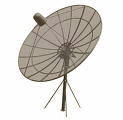Aerospace
Systems and Training LLC
LUNAR SPACE MISSION

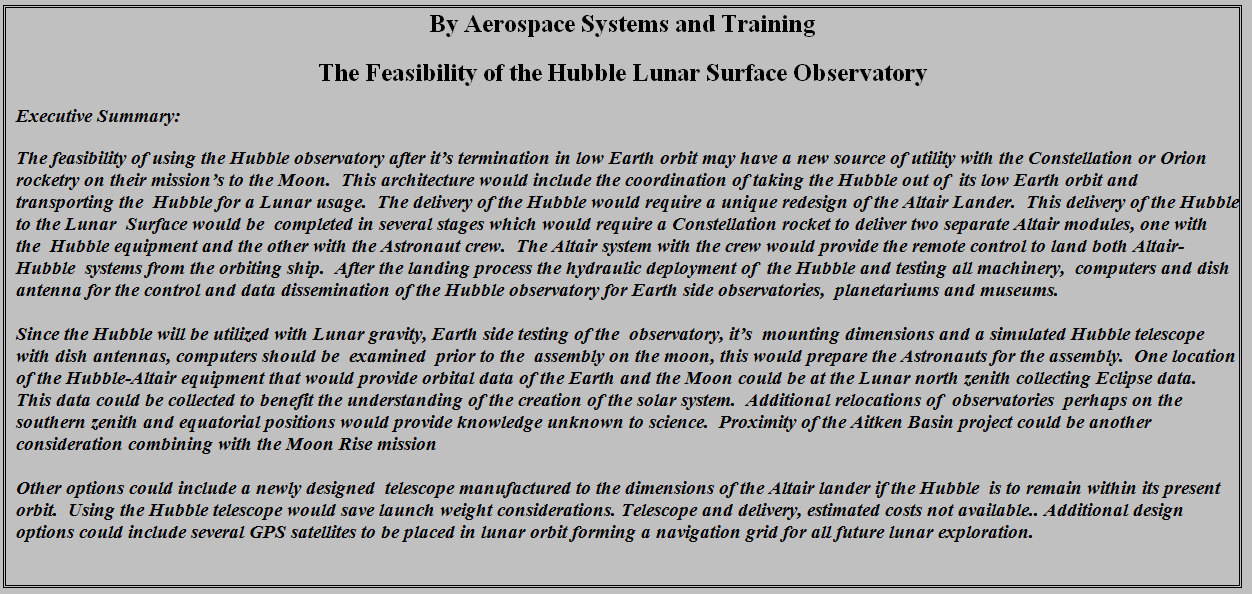
|
TABLE
OF CONTENTS |
I
Scientific/Technical/Management Section
II Servicing Concept with Constellation Systems
III Goals Pertinent to the Advancement of Science
IV Identification of Priority
V Development of New Technologies and Project Heritage
VI Risk Mitigation of the Use with the Constellation System
VII Data Storage and References
I Scientific/Technical/Management Section
Here are three
variants in architecture for the lander. The top one outpost lander weighs in
at 45,000 kg, middle lander is the standard cargo lander weighs in at 53,600
kg. the bottom lander would be designed to dock with the Hubble observatory.
The
modified Hubble will have a central storage bay within its center to provide
the Hubble equipment with a lunar lander. Once on the ground it would have its
secondary purpose as a mounting quad for the observatory. This quad would
provide motoring capabilities to direct the observatory from remote dish
antenna based near-by. A solar powered dish source would power the motoring for
the system. The lander is designed to carry a 14-17 metric ton load. The Hubble
weighs in at 24,500 lbs. 12.25 tons well within the weight limits. The base
perimeter of the lander is 31.16 feet x 31.16 feet is also within the 14-foot
width of the Hubble.
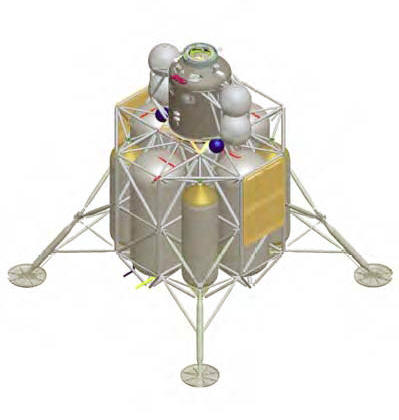
Altair
Standard Cargo Lander

Altair Hubble Lander

A 14-foot
expansion within the center of the Altair Lander would allow the positioning of
Hubble which would be retracted and extended into the lander with solar power
hydraulic arms. A motor at the base of the lander would turn the Hubble
toward its celestial angle. The combined equipment would be affected by
1/6 of its Earths weight on the moon. Solar panels and dish antenna would
be deployed around the perimeter of the landing sight, sending data back to
Earth.
Altair-Hubble Lander Crew & Antenna
Deployment

Crew and Hubble Deployment
Within the
Altair lander a set of hydraulic arms and levers will deploy the Hubble from
its landing configuration and prepare it for its first lunar celestial
angle. Antenna reception from NASA and other Earth observatory (example
Mount Palomar, Mount Wilson, SETI, U.S. museums and planetariums) will adjust
its position with dish antenna mounted around the system. Power
requirements from the solar panels would have to store sun light for the dark
phases of the moon. The present-day Hubble equipment would have to be
converted for its new scientific projects. New scientific data on
Eclipses and Earth Moon orbit would provide knowledge to the origins of the
complexity of the solar system. Data could be stored and compared at many
of the observatories and planetariums.
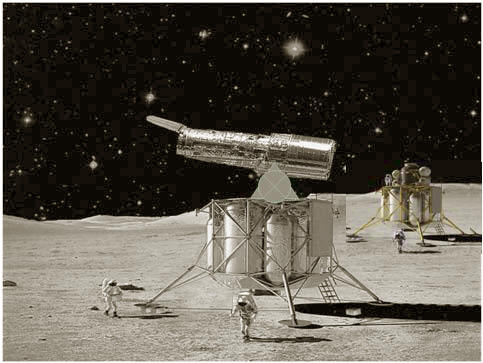
II Servicing Concept with Constellation Systems
The
servicing of the of the Constellation system would provide a launch of a double
Altair System one with the Astronaut group and the other with an Altair cargo
pod that would be used to deliver the Hubble observatory to the moon.
After launch the combined Altair system would orbit and take the Hubble out of
Earth orbit and proceed to the Moon entering a Lunar orbit. Once
established the double Altair module would separate in orbit and then descend
to the Lunar surface in conjunction. The Altair Hubble unit could be
controlled by both NASA on Earth and the Astronaut Altair system remotely.
Observing comets, stars and planets.
Landing
near each other the Astronauts would proceed to set up the Hubble observatory
deploying the Hubble out of the Altair. Configuring the dish antenna,
computer systems, solar power panels a preliminary test of the Hubble could be
initiated. There would be two solar panel systems one already attached on
the Hubble the other would be used to power the Altair combined robotic
observatory base system which would direct the Hubble telescope in the
celestial direction.
The
selection of the Lunar surface would take into consideration the section of the
Celestial sectors that would allow observation of Solar and Lunar Eclipses and
provide scientific data pertinent to the Earth and Lunar orbits. This
data could be helpful in mapping the creation of the solar system and provide
unknown scientific data pertinent to the mission. Below is a combined
design of the double Altair system and an assembled Lunar Hubble Altair
platform, dish antenna and solar panels not deployed.
Future Moon
mission could service and make necessary adjustments to the equipment.
Providing a base for other construction and development.

|
III Goals Pertinent to the
Advancement of Science |
The Hubble Lunar Observatory would provide a new use for the
Hubble and save taxpayer money at the tune of billions of dollars since the
observatory is scheduled for termination with the end of the Space Shuttle
program. The first observatory of its kind would require new science by
developing a lunar lander that can provide delivery and serve as a platform to
direct the observatory. This new technology would require a redesign of
the Altair lander to deliver and then deploy the observatory with hydraulic
lifts out of its holding camber. These hydraulic arms will be the
directing control fitted to a base motoring platform that could direct the
observatory on to its celestial angles. These directions would require dish
antenna deployed near the Altair to receive signals from NASA, for the
coordinates of selection. The system would also require a separate solar
panel to provide energy for the motoring of the motors. A redesign of the
Hubble could possibly also eliminate the present solar panels for energy
requirements of the Hubble and use the new ground based solar panels for the
Hubble energy requirements, thus reducing the weight of the system.
The
hydraulic arms and motoring system would have to be designed to work the
Hubble’s weight of 20.5 earth tons (3.403 moon tons). The Hubble would
have to be redesigned with a bracketing system to attach to the hydraulic arms
for the central axis of the pivoting angles. These brackets would be
installed in primary orbit of the Hubble prior to docking with the Altair cargo
lander. Removal of the present solar panels could allow ease of
installation.
Earth side
testing could take place with an Altair lander and simulated Hubble telescope
analyzing for stress and balance of the system and rocket delivery of the
lander. This could take place with Astronauts simulating real Lunar
conditions and deployment of the system and testing of the antenna and solar
panels. With this new scientific knowledge, man could learn to place
observatories throughout the solar system to learn of its nature and origins.
IV Identification of Priority
Based on budgetary availability developmental priority should include
the
following:
1.) Planning a written blueprint of the of the Altair lander to deliver
the
Hubble.
2.)
Development of rocketry necessary for the delivery to the Lunar
surface.
3.) Development of the solar panel requirements.
4.)
Development of the motoring, armature, and bracketing for the
Hubble.
5.) Development of the antenna control system.
6.) NASA assembly of the Altair Hubble lander.
7.)
Development of a Hubble simulation unit, dimensional and weight
equivalent.
8.)
Earth side testing of the Altair lander, rocketry, solar panels, antenna,
deployment and modifications necessary for
the real Hubble
observatory.
9.) Timeline for launching
the system.
10.) Modification necessary for
installation into the Constellation rocket.
11.) Launch and orbit with Hubble.
12.) Dock with Hubble.
13.) Remove Hubble’s solar panels.
14.) Deliver Altair/Hubble lander into
Lunar orbit.
15.) Deploy Astronaut and Hubble-Altair
landers.
16.) Ascend to Lunar surface.
17.) Assemble observatory and support
equipment.
18.) Test and adjust Hubble and base
observatory.
19.) Collect scientific data on celestial positions, eclipses, comets,
meteorites, planets, Earth/moon
orbit and any unknown data helpful
to science.
20.) Consider other missions with the
same scope.
21.) Provide Hubble data to NASA, observatories, planetariums,
and museums through the USA via
Lunar- Earth communications
systems.
V Development of New Technologies and Project
Heritage
The new technologies development would be the
robot systems built into the Altair lander that would control and power the
Hubble observatory creating a combined system. The system would have to
secure the Hubble for transportation to the Lunar surface. This could be
completed with brackets and magnetic belts holding the telescope to the lander
till arrival. Then hydraulic armature and motors powered by solar panels
to lift the telescope out of its lander retainer and deploy the telescope for
its celestial angle. Antenna deployment near the lander would be
connected to receive NASA Earth signals controlling the system once the
Astronauts depart the landing site.
Aerospace S. and T. heritage of this concept
was a Nassau Community College project term paper in Astronomy written in the
1970s by its PI Walter Barry. The term paper suggested a lunar
observatory with computers built on the moon. It did not include the
Hubble observatory but instead suggested a building with telescope and transmitting
computers. With the Hubble already in orbit a considerable savings in
launch weight should be considered.
VI Risk Mitigation of
the Use with the Constellation System
The timeline of threats on a mission to the
moon would require an analysis of each Phase of events. Phase 1; Earth
side this includes the rocket configuration, loading of the Altair landers,
crew configuration and training, processing the launch/launching. Phase 2, Low
Earth orbiting with the Hubble, then docking with the Hubble and leaving Earth
orbit. Phase 3, Earth moon transition launching to the moon and orbiting
with the moon. Phase 4, separating the two Altair Landers and descent of
the two Altair Landers with selection of landing positions and landing.
Phase 6, deployment of the of the crew, configuration of the Hubble, testing of
equipment. Phase 7, launching to low Lunar orbit and docking with
orbiting ship and departing Lunar orbit. Phase 8, Returning to Earth’s
orbit or the International Space Station. Phase 9, Re-entry to Earth and
parachuting of module. Phase 10, Crew medical screening and equipment
inspections.
Each area of study could be scaled with levels
of risk from 0-10 and equipment and crew could be tested and trained by
simulation on earth prior to mission timeline. This rehearsal could be
refined with checklists and photo analysis. Several timelines of mission could
be observed with various crews. The crews with the higher risk scores
should be processed out of the program while crews with the lower scores would
be screened again. Human and equipment limitations should be tested to
strategies tailored to fatigue and stress.
The International Space Station can be used to
provide a medical pit stop and check point of equipment prior to Earth’s
reentry. Earth orbit debris should be considered in all phases of mission
as well as Lunar orbit.
Orbits:
Orbits can be divided into four groupings. Orbit Alpha would launch a rocket with
equipment to cradle the Hubble. This can
include a stop at the ISS to pick up and drop off astronauts and equipment http://www.aerospacesandt.com/new_page_38.htm.
Orbit Beta would take the Hubble out of Earth's
orbit and deliver it to the Lunar surface.
In addition GPS satellites would be placed around the moon during the
mission http://www.aerospacesandt.com/Orbit%20Beta2.htm.
Orbit Gamma would bring back the astronauts to
Earth using Earth and moon based GPS http://www.aerospacesandt.com/new_page_43.htm.
Also see Lunar GPS for this concept http://www.aerospacesandt.com/lunar_gps.htm.
Orbit Delta would bring the astronauts back to Earth's orbit and surface delivering them to the ISS where they would be quarantined in a closed section of the ISS for medical clearing, and then a departure back into Earth's orbit for re-entry back to
Kennedy Space Center http://www.aerospacesandt.com/new_page_45.htm.
VII Data Storage and References
Suggested
Data storage link:
http://www.hec.nasa.gov/news/brochures/SCAP_HECC.pdf
References:
Lunar
Capability Concept Review (LCCR) June 18 – 20, 2008 Report to the PSS
Lunar
Program Industry Briefing Altair Overview Clinton Doris, Deputy Manager,
Altair
Project Office
Constellation
Program: America’s Spacecraft for a New Generation of Explorers the Altair
Lunar Lander Overview the Altair National Aeronautics and Space Administration
Lyndon B. Johnson Space Center Houston, Texas
77058www.nasa.govFS-2008-09-007-JSC
Project
Delayed: UFN
REQUEST FOR
INFORMATION (RFI)
Feasibility
of using Constellation Architecture for Servicing Existing and Future
Observatory-Class Scientific Spacecraft
Astrophysics
Division, Science Mission Directorate, NASA
Apollo The
NASA Mission Reports including Mission 12-13-14-15-16-17
General
Information:
Solicitation
Number: NNH09ZDA010L modified 2015
Release
Date: None
|
Aerospace
Systems and Training LLC Principle
Inspector 260
North Industrial Drive PO
Box 740263 Orange
City, Florida 32763-9998 1-386-801-3696
|
|
Space Mission
Artemis of the 21st Century will send the first female Astronaut
to the surface of the moon depending on the orbit selected it may be able to
fly over the older Apollo locations providing fresh photos of the older
landing sites. |

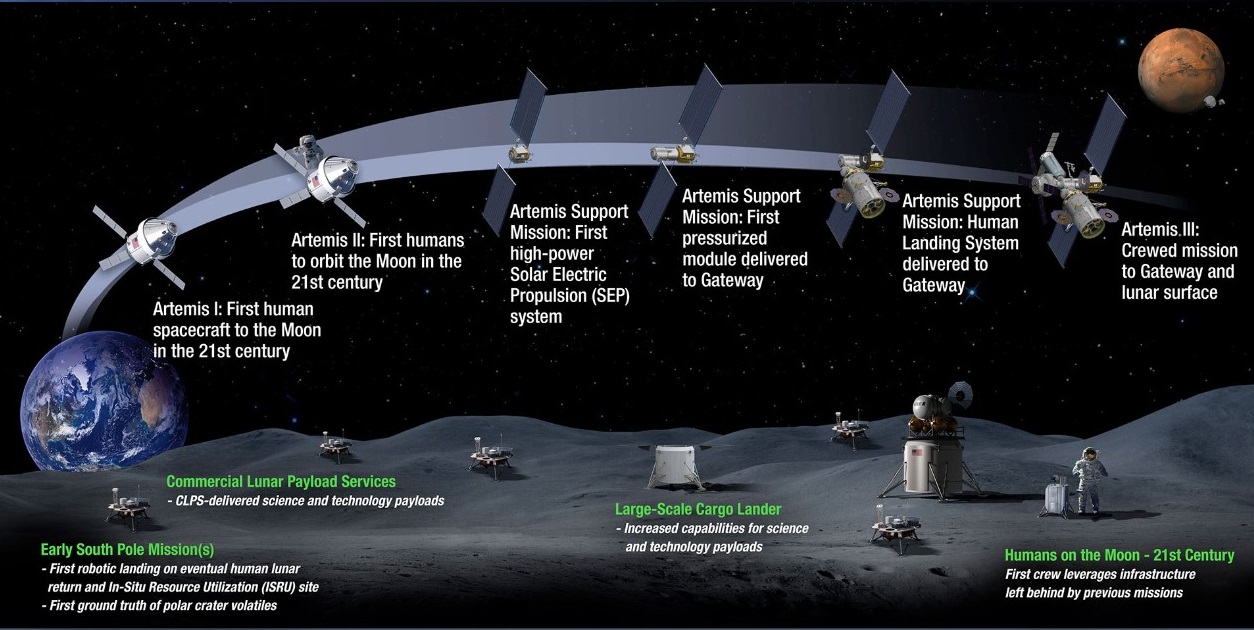

|
The Saturn V rocket was developed in the 1960s as part of
America’s goal to land a man on the moon and was used later to launch Skylab,
the first American space station. This
beautiful print features artwork acclaimed by artist Mark Karvon and captures
the moment the Saturn V leaves our atmosphere for its journey to the
moon. All these years later it is still
the most incredible machine to ever fly.
16” x 24”. |
|
Apollo To the Moon Saturn V Rocket Item # 705010 Unit Price: $79.95 |
Product
Support & Aerospace Consulting
Aerospace
Systems and Training LLC
260
North Industrial Drive
PO
Box 740263
Orange
City, Florida 32763-9998
Banner Link Below



Principle
Inspector
Walter
Barry
